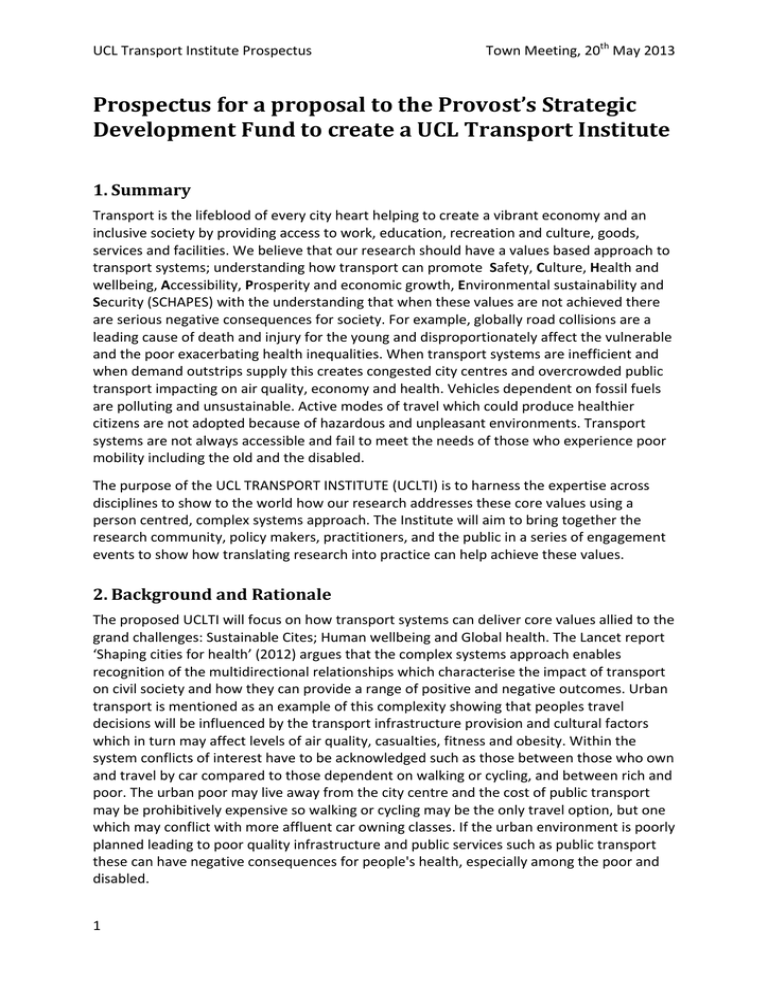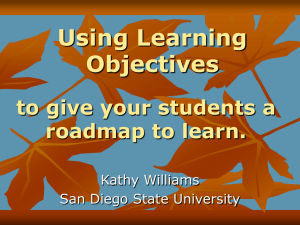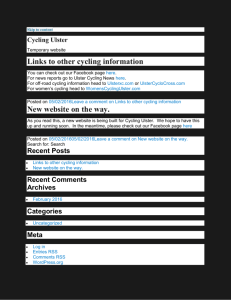Document 12611019
advertisement

UCL Transport Institute Prospectus Town Meeting, 20th May 2013 Prospectus for a proposal to the Provost’s Strategic Development Fund to create a UCL Transport Institute 1. Summary Transport is the lifeblood of every city heart helping to create a vibrant economy and an inclusive society by providing access to work, education, recreation and culture, goods, services and facilities. We believe that our research should have a values based approach to transport systems; understanding how transport can promote Safety, Culture, Health and wellbeing, Accessibility, Prosperity and economic growth, Environmental sustainability and Security (SCHAPES) with the understanding that when these values are not achieved there are serious negative consequences for society. For example, globally road collisions are a leading cause of death and injury for the young and disproportionately affect the vulnerable and the poor exacerbating health inequalities. When transport systems are inefficient and when demand outstrips supply this creates congested city centres and overcrowded public transport impacting on air quality, economy and health. Vehicles dependent on fossil fuels are polluting and unsustainable. Active modes of travel which could produce healthier citizens are not adopted because of hazardous and unpleasant environments. Transport systems are not always accessible and fail to meet the needs of those who experience poor mobility including the old and the disabled. The purpose of the UCL TRANSPORT INSTITUTE (UCLTI) is to harness the expertise across disciplines to show to the world how our research addresses these core values using a person centred, complex systems approach. The Institute will aim to bring together the research community, policy makers, practitioners, and the public in a series of engagement events to show how translating research into practice can help achieve these values. 2. Background and Rationale The proposed UCLTI will focus on how transport systems can deliver core values allied to the grand challenges: Sustainable Cites; Human wellbeing and Global health. The Lancet report ‘Shaping cities for health’ (2012) argues that the complex systems approach enables recognition of the multidirectional relationships which characterise the impact of transport on civil society and how they can provide a range of positive and negative outcomes. Urban transport is mentioned as an example of this complexity showing that peoples travel decisions will be influenced by the transport infrastructure provision and cultural factors which in turn may affect levels of air quality, casualties, fitness and obesity. Within the system conflicts of interest have to be acknowledged such as those between those who own and travel by car compared to those dependent on walking or cycling, and between rich and poor. The urban poor may live away from the city centre and the cost of public transport may be prohibitively expensive so walking or cycling may be the only travel option, but one which may conflict with more affluent car owning classes. If the urban environment is poorly planned leading to poor quality infrastructure and public services such as public transport these can have negative consequences for people's health, especially among the poor and disabled. 1 UCL Transport Institute Prospectus Town Meeting, 20th May 2013 The promotion of active mobility is seen as a key focus for future cities to support individual health and that this can be enhanced by ‘a city-­‐wide infrastructure of public spaces, incorporating urban greenery and water, which would also assist urban climate control, offer spaces for local food supply, and contribute to mental health.’ It is not just the infrastructure that needs to be changed; people perceptions have a significant role to play. Active mobility may only increase if people perceive the positive benefits for walking or cycling and their fears about crime and road safety are tackled. The Lancet report argued that providing equitable access to urban mobility should be a key feature of a healthy city stating that some 15% of the population has a disability that has serious implications for how they interact with the environment. Accessible urban environments can help disabled people have access to employment, leisure, health facilities, goods and services, recreation and culture. By contrast, inaccessible environments prevent disabled people from full participation and create avoidable burdens on families and support agencies. With an ageing demographic throughout the globe accessibility will become increasingly important. A key activity of the UCLTI will be to provide a platform for addressing complex systems issues that relate transport to other aspects of civil society such as: • • • • • • • • • • 2 How do we create modal shift from private cars to healthier more sustainable modes such as walking and cycling whilst making such activities safer at the same time? What is the relative effectiveness of capital investment in transport infrastructure versus revenue investment in behaviour change to create more active mobility? How can transport and urban mobility best address the needs of vulnerable groups in urban society? What role does the built environment play in encouraging walking and cycling? How important is walkability and ‘cycleability’, and what are the key aspects of this? How can information and technology change the way we travel by providing information or improving efficiency and becoming ‘smarter’? How can changes in the way we work reduce the need for utilitarian transport and what role can technology play in enabling us to work differently? How important is it for a street to be a place as well as a transport corridor and how can this be achieved? How can research inform policy regarding the interconnectedness of the core values in transport? What research methods can show the ‘multidirectionality’ of transport impacts on civil society? What is the role of political leadership and boldness in achieving a value based transport system? What is the relationship between culture and transport? UCL Transport Institute Prospectus Town Meeting, 20th May 2013 Answering these questions needs a multidisciplinary approach. For example, taking question 1: “How do we create modal shift from private cars to healthier more sustainable modes such as walking and cycling whilst making such activities safer at the same time?” several disciplines could be used to answer this question, the following list is by no means exhaustive: • • • • • • • • • • 3 Psychology to understand o how best to achieve behavioural change (modal shift) using psychological theory Sociology to understand o how different social groups (age, gender, ethnicity and social class) respond to cycling and what they see as the perceived opportunities or barriers to cycling History and art to understand o cultural responses to cycling over time o visual representations of cyclists o the use of media to promote cycling and safety Planning (Bartlett) to understand o how best to provide infrastructure for cycling o visualisation and navigation of cycling behaviour in the built environment o how to provide cycle friendly urban environments o how to create guidance to improve planning for cycling Epidemiology and public health to understand o injury patterns related to cycling o health inequalities related to cycling injuries o the health impacts of cycling Medicine to understand o the biomechanics of injury o the burden of injury Engineering (including Transport, Geomatics, Jill Dando Institute of Security and Crime Science) to understand o the role of infrastructure in encouraging cycling o the role of environmental change in improving safety o the need to provide security against bike theft o how to measure levels of cycling o contributory factors in cycling crashes Geography to understand o the spatial patterns of cycle use Economics to understand o the financial benefits of cycling Politics and law to understand o the role of political leadership in increasing cycling o the role of regulation in improving cycling safety e.g. helmets, training and the design of other vehicles to protect cyclists, such as HGVs o the role of evidence based policy making UCL Transport Institute Prospectus Town Meeting, 20th May 2013 3. Aims and objectives of the UCL TRANSPORT INSTITUTE Aims The aim of the UCLTI is to promote new cross-­‐disciplinary collaboration in research and bridge the translational gap to inform policy and practice and enhance societal relevance. Objectives: 1. Provide a centrally located transport hub mechanism to coordinate transport related research across UCL’s ten faculties 2. Develop a new web portal which will act as a platform to create collaborative research bids 3. Create a community of interest by developing a public engagement programme of seven seminars themed on research related the values of transport entitled ‘Mind the gap’—translating research into practice 4. To use EPSRC Impact Acceleration Fund to disseminate and promote the policy relevance of our research for practitioners, public and policy makers via briefing notes and published papers to made available via transport@UCL. 5. To develop a new MSc in Transport, Health and Policy to generate income 6. To develop income generating CPD 7. Hold a number of interdisciplinary research bid ‘sandpits’ based on key challenges 4. Organisation A hub-­‐and-­‐spoke model for transport research collaboration In this ‘service delivery’ model, the hub is a single centralised operation centre. The nodes are the points of delivery and the spokes are the communication routes between the nodes and the hub. The model will reflect the theme based approach transport research which reflects our aspirations of what the core values of transport systems should be. Our acronym for this approach to transport is SCHAPES: Safety, Culture, Health and wellbeing, Accessibility, Prosperity and economic growth, Environmental sustainability and Security (Figure 1). The core functions of the Hub are to provide leadership for collaboration based on the exchange of information, signposting to potential collaborators and dissemination especially via the website but also through public engagement events. The hub will also contain specialist crosscutting theme leaders on 1. Quantitative methods 2. Qualitative methods and 3. Policy and will have a full time administrator to maintain the web and facilitate communication and access to resources. The theme leaders will be responsible for ensuring that multiple disciplines are engaged on specific research questions relating to their theme. The spoke components of this model are access and communication channels e.g. a shared website and will help build capacity for research collaboration. The nodes are the individual SCHAPES themes whose leaders will maintain the flexibility and freedom to develop their own research areas. 4 UCL Transport Institute Prospectus Town Meeting, 20th May 2013 Figure 1. Safety, Culture, Health and wellbeing, Accessibility, Prosperity and economic growth, Environmental sustainability and Security (SCHAPES): a value based, complex systems approach to transport. Governance There will be a Director and a Steering Committee comprised of the senior representatives of the constituent groups. The Director and the Steering Committee would report quarterly to the Vice-­‐Provosts of Health, Research and Enterprise, and the Deans of UCL’s ten faculties. Staffing The Director for the Institute will be Nicola Christie. Nicola is the current Director of the Centre for Transport Studies, a psychologist with extensive public and private sector experience, as well as multidisciplinary academic experience. The Director’s role would be 0.4 FTE. The Director would be supported by a deputy director (Grade 8) to facilitate the communications, planning, public engagement, policy development, research and training developments of the institute (including CPD and input into the new MSc). A teaching fellow (.6 FTE Grade 6) will be employed to backfill teaching and to support new CPD and MSc programmes. 5



